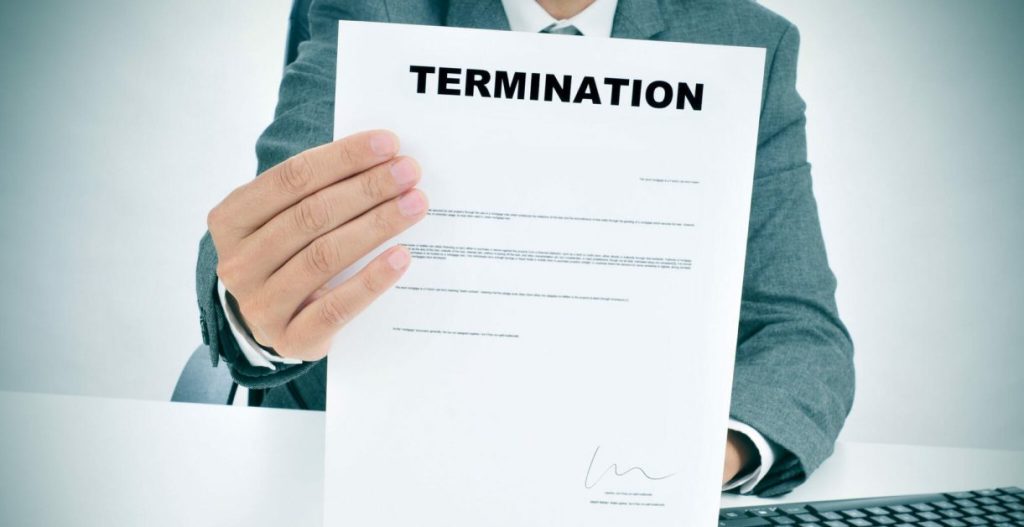A tenancy agreement is a legally binding contract, and as such, it may only be terminated under a limited number of circumstances in fixed term or periodic tenancy agreement to terminate a lease. .
In most cases, either the landlord or the tenant will give notice to the other party in order to terminate a tenancy agreement early, with the tenant being required to vacate the premises by the date mentioned in the termination notice in writing.
To end a tenancy, either the landlord or the tenant is required to hand the other party a written termination notice that specifies the amount of time that the notice period will be in effect.
Steps to Formally End a Periodic Tenancy Agreement
- Prepare a Written Notice: Draft a formal termination notice. It’s essential that this notice clearly states the termination date and adheres to any legal notice periods required by local regulations.
- Serve the Notice: You can serve the notice by mail, email (to an address specified for such documents), or in person. Ensure that the method you choose complies with your local tenancy laws to avoid any disputes.
- Utilize a Template: Consider using a template letter to ensure all necessary details are included. Customize the template by substituting your personal details where appropriate.
- Seek Additional Information: For further guidance, consult resources or factsheets available from trusted housing organizations. These resources can provide detailed insights into your rights and responsibilities.
If the circumstances are right, either the landlord or the tenant may petition the Tribunal for a termination order without first being required to give the required termination notice as per residential tenancies act.
By following these steps, you can ensure a smooth and legally compliant end to your periodic tenancy agreement.
How a Landlord Can Lawfully End a Tenancy Agreement
When it comes to ending a tenancy agreement, landlords must adhere to a legal process to ensure everything is conducted correctly. Generally, this involves providing the tenant with a formal notice to vacate.
Steps a Landlord Must Take
- Issuing a Notice: The first step in legally ending a tenancy is for the landlord or agent to deliver a written notice of termination to the tenant. This notice must clearly specify the date by which the tenant is expected to vacate the property and return the keys.
- Tenant Compliance: If the tenant moves out by the stated date and returns the property in accordance with the notice, the agreement concludes amicably.
- Action If Tenant Stays: If the tenant does not vacate by the outlined date, the landlord must escalate the matter to a legal authority, such as the NSW Civil and Administrative Tribunal (NCAT), by applying for a termination order.
- Termination Order: This legal order officially ends the tenancy and mandates the tenant to vacate the premises by the specified date.
Important Considerations
- The notice and any subsequent legal actions create a documented timeline that helps in ensuring both parties understand their rights and responsibilities.
- The process allows for a structured and fair resolution if the tenant chooses not to comply with the initial notice.
By following this procedure, landlords can end a tenancy agreement lawfully and avoid potential legal complications.
Minimum notice period
Both the kind of agreement (whether it be a fixed-term agreement or a periodic agreement) and the grounds for termination influence the length of the period of notice with break fee if applicable.
These notice periods are intended to provide renters with the time to discover an alternative rental property and provide landlords with sufficient time to find a new tenant.
At any moment during the tenancy, the landlord and tenant can mutually agree to terminate the lease. A list of the required minimum amounts of notice
The Residential Tenancies Act 2010 stipulates that to terminate a tenancy agreement, a 21-day notice period is required. This means that when a tenant or landlord decides to end the lease, they must provide a written notice to the other party at least 21 days in advance. This rule ensures both parties have sufficient time to make necessary arrangements before the tenancy formally concludes.
Understanding Tenant Rights in NSW: A Summary
Tenants in New South Wales have certain protections under the Residential Tenancies Act 2010 and the Residential Tenancies Regulation 2019. These two pivotal regulations establish what landlords must legally do to terminate a lease appropriately.
Key Rights for Tenants:
- Fair Notice for Lease Termination:
- Landlords must provide specific notice periods before ending a tenancy. This allows tenants adequate time to find a new residence.
- Privacy and Entry Protocols:
- Landlords must follow legal protocols for entering the premises, ensuring tenant privacy is respected.
- Repair and Maintenance Standards:
- Tenants are entitled to a habitable living environment, and landlords are obligated to maintain the property to a reasonable standard.
- Bond and Rent Regulations:
- Regulations around rental bonds and maximum rent increase frequencies prevent unforeseen financial strain on tenants.
- Dispute Resolution:
- Tenants have access to mechanisms for resolving conflicts, such as disputes over repairs or rent increases.
These rights are designed to balance the needs of both tenants and landlords, promoting fair treatment in residential leases. For more comprehensive guidance, tenants should refer to official resources or legal advice focused on NSW regulations.
A notification of termination
A notice of termination must be in writing, signed and dated by the party giving the notice, include the address of the rented property, state the day the tenancy agreement is terminated (and by which the tenant will need to move out), and include the reasons for termination.
A notice of termination must be in writing, signed and dated by the party giving the notice (if applicable).Notices of termination are not need to coincide with the monthly rent payment cycle and can be made at any point throughout the tenancy.
If it becomes necessary, a landlord who has already given a notice of termination is able to offer a second notice based on other grounds.
If a landlord, for instance, provides a tenant with 90 days’ notice that they intend to terminate a periodic tenancy without providing a reason, and then the tenant fails to pay rent for a period of 14 days, the landlord has the right to terminate the tenancy based on the tenant’s failure to pay rent.

Tenants have a variety of reasons for giving notice.
What Happens When There’s an Error in the Termination Notice?
If there’s an error in the termination notice, or it wasn’t sent or delivered correctly, this could potentially be your defense if the landlord seeks a termination order. Here’s what you should know:
- Challenge the Validity: You have the right to argue before the Tribunal that the notice is invalid. If you can demonstrate the mistake or evidence of improper delivery, you could potentially have the landlord’s application dismissed.
- Proceed with Caution: Keep in mind, the Tribunal might not always accept this argument. They sometimes decide to overlook minor errors, particularly if the mistake doesn’t significantly prejudice the tenant.
- Prepare Evidence: Gather any evidence of mistakes or improper delivery, like incorrect dates or missing information, to strengthen your case.
- Legal Assistance: Consider seeking advice from a legal expert, such as a tenant’s advocate or lawyer, to enhance your chances of a favorable outcome.
Understanding these nuances can help you navigate any disputes over termination notices more effectively.
The conclusion of a contract
If renters desire to depart at the conclusion of their renting agreement, they are required to offer a notice period of 28 days (lease).
You may also like to read: Tips To Find Property Value In Australia
If renters on fixed-term agreements, such as a 12-month deal, do not give notice before their agreement rolls over into a month-to-month arrangement, the fixed-term agreement will be terminated.
Is Termination Possible When the Property is Sold During a Fixed-Term Lease?
When you’re in a fixed-term lease, a common concern arises: what happens if the property is being sold? Typically, the sale of a property alone does not permit the termination of a fixed-term lease. Here’s why:
- Lease Stability: A fixed-term lease is designed to provide you with housing stability for the entire duration of the agreement. This means that even if the owner decides to sell, your lease remains intact.
- Legal Protections: Tenancy laws in many regions protect tenants from having their fixed agreements terminated solely due to a property sale. This ensures that tenants are not forced to relocate unexpectedly.
- Buyer Obligations: When a property is sold with tenants, the new owner generally assumes the lease agreement as is. They cannot legally terminate the lease without cause or outside of the originally agreed-upon terms.
In summary, a fixed-term lease provides you with rights that prevent termination simply because of an impending sale. Always review your lease and consult local regulations to understand your specific situation fully.
Understanding Retaliatory Eviction and How to Challenge It
Retaliatory eviction occurs when a landlord attempts to terminate a lease in response to a tenant exercising their legal rights, such as requesting necessary repairs. This unlawful action aims to penalize tenants for standing up for themselves. However, tenants have the right to challenge this in a legal setting.
Steps to Challenge a Retaliatory Eviction:
- Recognize the Problem: If you’ve received a termination notice shortly after exerting your rights as a tenant (like filing a complaint or asking for repairs), it could be retaliatory.
- Take Timely Action:
- Periodic Agreements: If you’ve received a 90-day notice, you must file a complaint within 30 days.
- Other Notices: The time frame shortens to 14 days for other types of notices.
- Attend Tribunal Hearings:
- If the landlord has initiated a termination order with the tribunal, make an appearance. Clearly assert that the eviction is retaliatory, presenting any evidence you have to support your case.
- Understanding Outcomes:
- If the tribunal determines the eviction notice was retaliatory, they may rule it invalid.
- Should a termination order be issued, the tribunal will assess the hardships faced by both parties and decide a date for you to vacate the premises.
- Eviction Protocols:
- If the tribunal orders termination, and you stay beyond the prescribed date, the landlord might obtain a warrant for possession. This means a sheriff’s officer, potentially aided by police, can enforce the eviction.
By knowing your rights and the proper procedures to challenge a retaliatory eviction, you’re better equipped to protect your tenancy and ensure fair treatment.
Can a Landlord End a Fixed-term Agreement Without Grounds?
No, a landlord cannot simply end a fixed-term lease without a valid reason before the lease expires. The lease is legally binding for its entire duration. If the landlord wishes to terminate the lease precisely at its end, they are required to provide you with a notice period. Typically, this notice needs to be at least 30 days and should clearly indicate that it coincides with the lease’s last day.
Once the fixed-term lease period concludes, if neither party acts to end the agreement, it transitions into a periodic tenancy. During this phase, different rules for termination and notice periods may apply.
Early warning that does not constitute a breach of the agreement
There are a few situations in which a renter can vacate the premises before the conclusion of the rental agreement without being in violation of the terms of the lease and without being responsible for any additional fees.
In the event that any of these circumstances arise, the tenant is required to provide written notification.
In violation of the agreement
If tenants provide notice before the end of the rental agreement for any cause other than the one specified in the rental agreement, they will be in violation of the rental agreement. They could have to cover the expenses and reach an agreement.
Commitment to depart without providing advance notification
A tenant has the right to enquire with the rental provider about the possibility of vacating the premises without first providing an official notice of their plan to do so. There is no requirement for the landlord to provide permission. If they do, the agreement has to be put in writing for future reference.

Tenants who are victims for domestic abuse
A tenancy agreement is a legally binding contract, and as such, it may only be terminated under a limited number of circumstances.
You may also like to read: Is it ultimately better to rent or own a home?
In most cases, either the landlord or the tenant will give notice to the other party in order to terminate a tenancy, with the tenant being required to vacate the premises by the date mentioned in the termination notice as per the tenants advice and advocacy council.
To end a tenancy, either the landlord or the tenant is required to hand the other party a written termination notice that specifies the amount of time that the notice period will be in effect.
If the circumstances are right, either the landlord or the tenant may petition the Tribunal for a termination order without first being required to give the required termination notice.
If renters do not depart
If a tenant provides notice but does not vacate the premises, the landlord has the right to petition the Administrative Tribunal for an order compelling the renter to vacate the premises. This may result in the eviction of the tenant.
Once notice to terminate a tenancy agreement has been given, several steps should follow to ensure a smooth transition:
How to Challenge a Retaliatory Eviction Notice at the Tribunal
If you believe your landlord is evicting you unfairly because you exercised your legal rights, such as requesting necessary repairs, you may be dealing with a retaliatory eviction. Here’s how to challenge it:
Understanding Retaliatory Evictions
A retaliatory eviction occurs when a landlord seeks to terminate your tenancy in response to you asserting your legal rights. This action is often illegal and can be contested at the Tribunal.
Steps to Challenge the Notice
- Apply to the Tribunal:
- To dispute the eviction notice, file an application with the Tribunal promptly.
- If your tenancy is under a periodic agreement and you’ve received a 90-day notice, you must submit your application within 30 days.
- For other types of notices, the window to apply is within 14 days.
- Prepare for the Hearing:
- If the landlord has already sought a termination order from the Tribunal, it is crucial to attend the hearing.
- During the hearing, present your case by clearly stating that the eviction is retaliatory. Gather any evidence that supports your claim, such as maintenance requests or communications with the landlord.
Key Tips
- Documentation: Keep records of all communications and requests related to your tenancy.
- Timeliness: Ensure you act within the specified timeframes to strengthen your case.
- Legal Advice: Consider seeking legal advice to better prepare your arguments and navigate the Tribunal process.
Consequences of Conducting an Illegal Lockout
Landlords who proceed with evicting a tenant without the requisite legal proceedings face significant consequences. An eviction can only occur with an official order from a court or tribunal. If a landlord bypasses this process and illegally locks out a tenant, they could face substantial penalties.
Here are the potential repercussions a landlord may encounter:
- Hefty Fines: Engaging in an illegal lockout can result in fines of up to $22,000. This serves as a stern warning to landlords to adhere to legal procedures.
- Compensation to Tenants: Besides fines, landlords might also be ordered to compensate the tenant for the inconvenience and loss suffered due to the unlawful lockout. For example, a tribunal previously mandated a landlord to pay $2,000 for denying a tenant the enjoyment of their residence.
It’s crucial for landlords to comply with the legal eviction processes to avoid these penalties. Skipping the proper channels not only leads to financial repercussions but damages reputations as well.
By taking these steps, you can effectively challenge a retaliatory eviction notice and protect your rights as a tenant.
- Communication: The landlord or property manager should schedule a time to discuss the next steps, ensuring all parties are on the same page.
- Inspection Arrangement: Both the tenant and the landlord should agree on a suitable time to inspect the premises together. This joint inspection helps to address any discrepancies regarding the property’s condition.
- Condition Report: During the inspection, a condition report should be completed. This document serves as a crucial record of the property’s state, protecting both the landlord’s and tenant’s interests.
- Key Return: Once the inspection and condition report are finalized, the tenant should return the keys to the landlord. This step signifies the official handover of the property.
The property will be further checked with the condition report, and a complete end-of-lease cleaning will be carried out by the landlord for the new tenant to move in.
These steps ensure a transparent and organized process, minimizing potential conflicts and setting a clear path forward for both parties involved.
The property will be further checked with the condition report and a complete end of lease cleaning will be carried out by the landlord for the new tenant to move in\
Situations Allowing Immediate Notice by a Landlord
A landlord has the right to issue an immediate notice to tenants under specific circumstances. Here’s when this may occur:
- Destruction or Damage: If a property is severely damaged or destroyed, making it fully or partially uninhabitable due to events like fire or floods—events that are not caused by tenant actions.
- Legal Restrictions: If new legal restrictions render the property unfit for living, such as changes in zoning laws or safety regulations.
- Government Acquisition: Should a government authority take over the property, perhaps for infrastructure projects like building new roads, the landlord can provide immediate notice.
These stipulations ensure both tenants and landlords know their rights and responsibilities in extraordinary situations.

The procedure for giving notice
The written notification is required to be sent by the tenant. The use of this form is not required, however we strongly advise all renters to fill out and submit our Notice of Intention to Vacate Rented Premises by Renter.
Having a notice to quit delivered to you
The following are the acceptable methods for delivering the notice of intent to depart to the landlord:
- Mail: This traditional method requires you to factor in delivery times, which can be calculated using resources like the Australia Post website. Ensure you allow sufficient time for the notice to reach its destination.
- Email: You must send the notice to an email address specifically designated by the recipient for such documents. It’s a quick and efficient method but requires prior consent from the landlord for this mode of communication.
- In Person: Hand-delivering the notice ensures immediate receipt. When using this method, handwritten notes should accompany any electronic communication, such as emails, to provide a personal touch and confirm delivery.
Consider the following factors when estimating when your letter will arrive: your chosen method of delivery and the location from which you are mailing your notification.
If you are going the route of posting the notification, it is essential to provide adequate time for the mail to be delivered. . Calculating expected delivery times may be done on the website of Australia Post.






